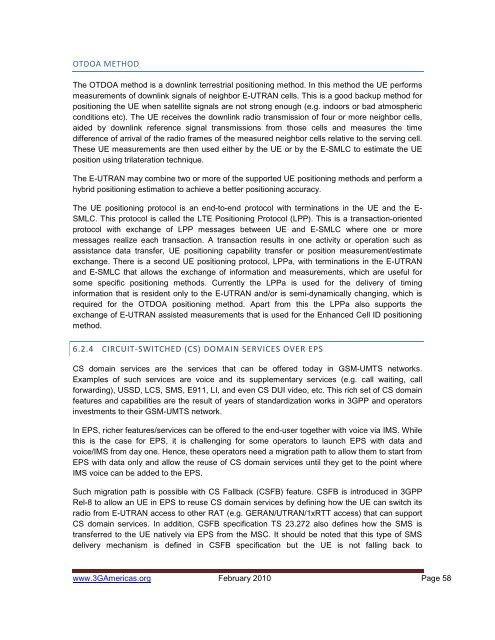UMTS: Alive and Well - 4G Americas
UMTS: Alive and Well - 4G Americas
UMTS: Alive and Well - 4G Americas
Create successful ePaper yourself
Turn your PDF publications into a flip-book with our unique Google optimized e-Paper software.
OTDOA METHODThe OTDOA method is a downlink terrestrial positioning method. In this method the UE performsmeasurements of downlink signals of neighbor E-UTRAN cells. This is a good backup method forpositioning the UE when satellite signals are not strong enough (e.g. indoors or bad atmosphericconditions etc). The UE receives the downlink radio transmission of four or more neighbor cells,aided by downlink reference signal transmissions from those cells <strong>and</strong> measures the timedifference of arrival of the radio frames of the measured neighbor cells relative to the serving cell.These UE measurements are then used either by the UE or by the E-SMLC to estimate the UEposition using trilateration technique.The E-UTRAN may combine two or more of the supported UE positioning methods <strong>and</strong> perform ahybrid positioning estimation to achieve a better positioning accuracy.The UE positioning protocol is an end-to-end protocol with terminations in the UE <strong>and</strong> the E-SMLC. This protocol is called the LTE Positioning Protocol (LPP). This is a transaction-orientedprotocol with exchange of LPP messages between UE <strong>and</strong> E-SMLC where one or moremessages realize each transaction. A transaction results in one activity or operation such asassistance data transfer, UE positioning capability transfer or position measurement/estimateexchange. There is a second UE positioning protocol, LPPa, with terminations in the E-UTRAN<strong>and</strong> E-SMLC that allows the exchange of information <strong>and</strong> measurements, which are useful forsome specific positioning methods. Currently the LPPa is used for the delivery of timinginformation that is resident only to the E-UTRAN <strong>and</strong>/or is semi-dynamically changing, which isrequired for the OTDOA positioning method. Apart from this the LPPa also supports theexchange of E-UTRAN assisted measurements that is used for the Enhanced Cell ID positioningmethod.6.2.4 CIRCUIT-SWITCHED (CS) DOMAIN SERVICES OVER EPSCS domain services are the services that can be offered today in GSM-<strong>UMTS</strong> networks.Examples of such services are voice <strong>and</strong> its supplementary services (e.g. call waiting, callforwarding), USSD, LCS, SMS, E911, LI, <strong>and</strong> even CS DUI video, etc. This rich set of CS domainfeatures <strong>and</strong> capabilities are the result of years of st<strong>and</strong>ardization works in 3GPP <strong>and</strong> operatorsinvestments to their GSM-<strong>UMTS</strong> network.In EPS, richer features/services can be offered to the end-user together with voice via IMS. Whilethis is the case for EPS, it is challenging for some operators to launch EPS with data <strong>and</strong>voice/IMS from day one. Hence, these operators need a migration path to allow them to start fromEPS with data only <strong>and</strong> allow the reuse of CS domain services until they get to the point whereIMS voice can be added to the EPS.Such migration path is possible with CS Fallback (CSFB) feature. CSFB is introduced in 3GPPRel-8 to allow an UE in EPS to reuse CS domain services by defining how the UE can switch itsradio from E-UTRAN access to other RAT (e.g. GERAN/UTRAN/1xRTT access) that can supportCS domain services. In addition, CSFB specification TS 23.272 also defines how the SMS istransferred to the UE natively via EPS from the MSC. It should be noted that this type of SMSdelivery mechanism is defined in CSFB specification but the UE is not falling back towww.3G<strong>Americas</strong>.org February 2010 Page 58
















